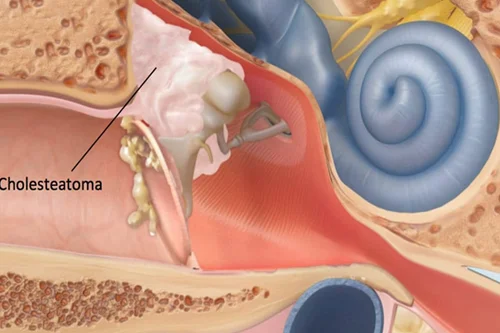Cholesteatoma
Cholesteatoma

Cholesteatoma is an abnormal, non-cancerous growth of skin cells inside the middle ear, behind the ear drum. Although it may sound harmless, cholesteatoma can slowly damage the delicate structures of the ear — including the tiny hearing bones — and, if untreated, lead to serious complications such as permanent hearing loss, facial nerve weakness, dizziness, or even spread of infection to the brain.
Common Causes Of Cholesteatoma
- Repeated ear infections
- Ear drum perforation (hole in the ear drum)
- Long-term negative pressure in the middle ear pulling the ear drum inward
- Rarely, present from birth (congenital cholesteatoma)
Symptoms
- Persistent ear discharge with a bad smell
- Gradual hearing loss
- A feeling of fullness or pressure in the ear
- Dizziness or balance issues (in advanced cases)
- Facial muscle weakness (if the nerve is affected)
How Does Cholesteatoma Grow Silently?
Cholesteatoma often grows slowly and painlessly at first, so many people don’t realize they have it. The skin cells inside the ear keep collecting and form a cyst-like sac. This sac produces enzymes that can destroy bone and tissue. That’s why even though it may seem like just a stubborn ear discharge, cholesteatoma can quietly cause serious damage over time.
Treatment
- Surgery is the main treatment: The goal is to fully remove the cholesteatoma, stop the infection, and protect hearing and other structures. This is often done through a mastoidectomy (cleaning out the bone behind the ear).
- Follow-up care is essential : Cholesteatoma can come back, so patients need regular ear check-ups and hearing tests.
- Hearing repair may be done later : through a second surgery (ossiculoplasty) if the small bones of hearing were damaged.
Don’t ignore persistent ear discharge or hearing loss — early care makes a difference.Book your ENT consultation today and protect your hearing.Cholesteatoma can be serious — let’s treat it before it causes permanent damage
